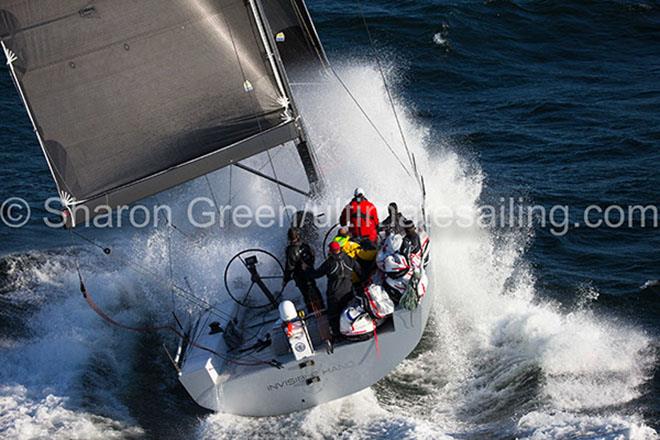
An interview with Manny Gomez about the 2019 SoCal 300
by David Schmidt 28 May 2019 16:00 BST
May 31-June 1, 2019

2017 SoCal 300 © Sharon Green / ultimatesailing
While California might not have an excessive number of welcoming harbors for cruising sailors, it’s enviably long, north-to-south waterline makes it ideal for distance racing, especially if you don’t mind sometimes-cold water, sometimes-strong winds, and seas that enjoy a “significant” amount of fetch. But catch the conditions right, and the sailing can involve a lot of fun, fast angles, plenty of Pacific Ocean spray, and the chance to light up the offshore afterburners. For example, the SoCal 300 (May 31-June 1) starts on the waters off of Santa Barbara and takes the fleet of competing boats south to San Diego, passing the islands and the entrance to Los Angeles Harbor before crossing the finishing line between two San Diego channel-entrance buoys (“SD 5” and “SD 6”).
Not surprisingly, the West Coast’s fleet of sleds is well-represented, with five Santa Cruz 50/52s, an Andrews 56 (Shawn Bennett’s Cipango), a R/P 66 (Phillip Turner’s Alive), and a Custom 76 (Paul Scripps’ Miramar), not to mention a Rogers 46 (Bob Pethick’s Bretwalda3) and—on the other end of the LOA spectrum—a Hobie 33 (Chris Lemke and Brad Lawson’s Dark Star).
The SoCal 300 is part of the bigger California Offshore Race Week, which includes the Spinnaker Cup (San Francisco to Monterey, May 25-26) and the Coastal Cup (Monetary to Santa Barbara, May 29), and which is sponsored by the Encinal Yacht Club, Monterey Peninsula Yacht Club, Santa Barbara Yacht Club, and the San Diego Yacht Club. The SoCal 300 will use the ORR handicap rule to score all monohulls, and boats must be 23’9” LOA, or longer, to compete.
I checked in with Manny Gomez, who serves as chair of the SoCal 300, via email, to learn more about this exciting West Coast offshore challenge.
How many boats are you expecting at this year’s SoCal 300? Also, how does this compare to the numbers and the competition levels that you have seen in recent years?
This year, we are expecting over 25 boats. A lot of boats use this race as a TransPac shakedown race, so we usually see higher turn out during TransPac years.
We are also excited to have a lot of international yachts participating in the 300 or the entire offshore race week series, which are doing West Coast races leading up to TransPac.
In your mind, what are the toughest parts of the SoCal 300’s course?
The toughest parts of the 300 course are going through the islands. The race can be thrilling at first, and it historically gets light down south before the turn into San Diego. Keeping the crew alert and safe are some of the toughest parts, in my opinion.
What are the best-case and worst-case scenarios in terms of weather? Also, what is it about these conditions relative to the course that inspires your answers?
Last year, we looked at modifying the racecourse because the weather forecast looked potentially dangerous. Forecast was calling for breeze steadily in the 20s with stingers up in the 30s, and sea state was 2-3 meters.
Most of the sailors wanted the challenging conditions, and the OA’s and Race Chairs reviewed weather reports from several professional sources and decided to keep the existing course.
Do most SoCal 300 sailors also take part in the Spinnaker Cup and the Coastal Cup (e.g., the larger California Offshore Race Week), or does the SoCal 300 have its own established following? Can you explain the race’s culture to the uninitiated?
The Offshore Race Week is a big commitment, but it was designed so sailors could any or all the legs and be scored accordingly. We have seen a lot of people do the series and they thoroughly enjoy it.
The 300 also has its own following, as a boat delivery from SoCal to Santa Barbara is a lot shorter than a boat delivery to San Francisco. We also design the race to integrate with the Santa Barbara “Wet Wednesday” series so there is a fun, warm up race, send-off party.
What’s the standing course record, and-looking at this year’s scratch sheet-are you seeing any potential history-book disruptors?
The Pac52, Invisible Hand, owned by Frank Slootman, holds the record at 13:14:35, [which they posted] in 2017. They used this race as a TransPac shake-down.
Do you have any advice that you’d like to share with first-time racers? What about returning racecourse veterans?
My mantra in yachting is “safety never takes a holiday” With that being said, make sure to watch where you are stepping, what you are holding onto, and where your head is.
Can you tell us about any steps that you and the other event organizers have taken in the last couple years to help green-up the regatta or otherwise lower its environmental wake?
One of our biggest priorities is protecting our playground for future generations. We ban yarn to bind spinnakers, but biodegradable and/or reusuable material such as Velcro are permitted and encouraged to band spinnakers.
Anything else that you’d like to add, for the record?
We added the California Offshore 500 this year, which starts in San Francisco [and] picks up with the SoCal 300 and finishes all offshore San Diego. This is meant for large, fast yachts that may not be able to get into Santa Barbara Harbor because of draught. This year, I am proud to say we have 3 MOD 70s entered, which will all be doing TransPac!